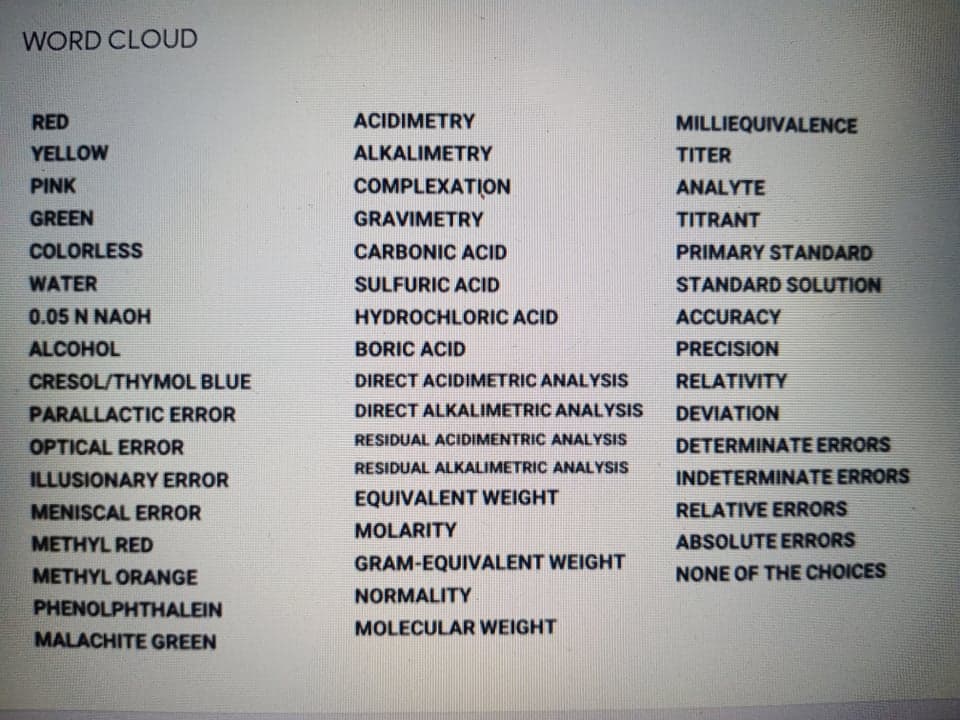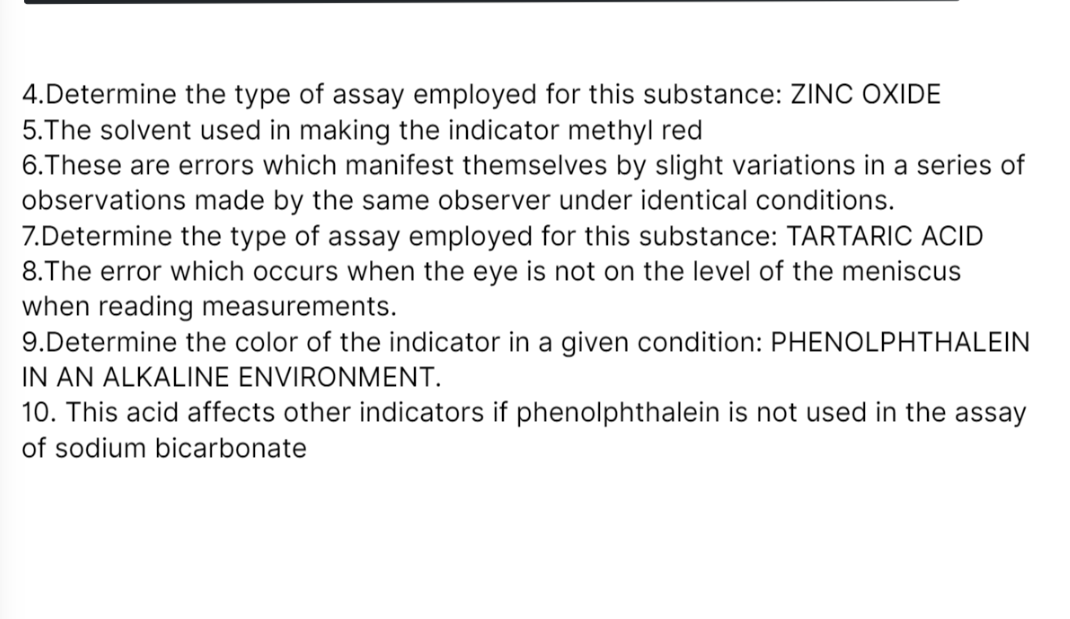4.Determine the type of assay employed for this substance: ZINC OXIDE 5.The solvent used in making the indicator methyl red 6.These are errors which manifest themselves by slight variations in a series of observations made by the same observer under identical conditions.
4.Determine the type of assay employed for this substance: ZINC OXIDE 5.The solvent used in making the indicator methyl red 6.These are errors which manifest themselves by slight variations in a series of observations made by the same observer under identical conditions.
Chapter3: Statistical Tests With Excel
Section: Chapter Questions
Problem 6P
Related questions
Question
HELLO PLS HELP ME WITH THIS ONE. THE ANSWERS ARE ON THE WORD CLOUD

Transcribed Image Text:WORD CLOUD
RED
ACIDIMETRY
MILLIEQUIVALENCE
YELLOW
ALKALIMETRY
TITER
PINK
COMPLEXATION
ANALYTE
GREEN
GRAVIMETRY
TITRANT
COLORLESS
CARBONIC ACID
PRIMARY STANDARD
WATER
SULFURIC ACID
STANDARD SOLUTION
0.05 N NAOH
HYDROCHLORIC ACID
ACCURACY
ALCOHOL
BORIC ACID
PRECISION
CRESOL/THYMOL BLUE
DIRECT ACIDIMETRIC ANALYSIS
RELATIVITY
PARALLACTIC ERROR
DIRECT ALKALIMETRIC ANALYSIS
DEVIATION
OPTICAL ERROR
RESIDUAL ACIDIMENTRIC ANALYSIS
DETERMINATE ERRORS
RESIDUAL ALKALIMETRIC ANALYSIS
ILLUSIONARY ERROR
INDETERMINATE ERRORS
EQUIVALENT WEIGHT
MENISCAL ERROR
RELATIVE ERRORS
MOLARITY
METHYL RED
ABSOLUTE ERRORS
GRAM-EQUIVALENT WEIGHT
METHYL ORANGE
NONE OF THE CHOICES
NORMALITY
PHENOLPHTHALEIN
MOLECULAR WEIGHT
MALACHITE GREEN

Transcribed Image Text:4.Determine the type of assay employed for this substance: ZINC OXIDE
5.The solvent used in making the indicator methyl red
6.These are errors which manifest themselves by slight variations
observations made by the same observer under identical conditions.
7.Determine the type of assay employed for this substance: TARTARIC ACID
8.The error which occurs when the eye is not on the level of the meniscus
when reading measurements.
9.Determine the color of the indicator in a given condition: PHENOLPHTHALEIN
IN AN ALKALINE ENVIRONMENT.
10. This acid affects other indicators if phenolphthalein is not used in the assay
a series of
of sodium bicarbonate
Expert Solution
This question has been solved!
Explore an expertly crafted, step-by-step solution for a thorough understanding of key concepts.
This is a popular solution!
Trending now
This is a popular solution!
Step by step
Solved in 4 steps

Knowledge Booster
Learn more about
Need a deep-dive on the concept behind this application? Look no further. Learn more about this topic, chemistry and related others by exploring similar questions and additional content below.Recommended textbooks for you


Principles of Instrumental Analysis
Chemistry
ISBN:
9781305577213
Author:
Douglas A. Skoog, F. James Holler, Stanley R. Crouch
Publisher:
Cengage Learning


Principles of Instrumental Analysis
Chemistry
ISBN:
9781305577213
Author:
Douglas A. Skoog, F. James Holler, Stanley R. Crouch
Publisher:
Cengage Learning